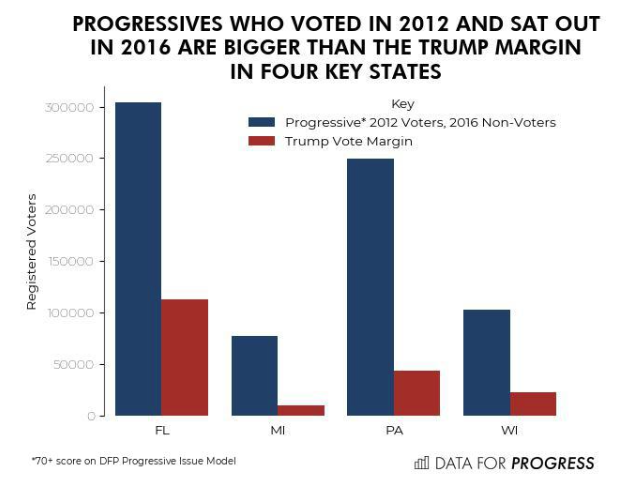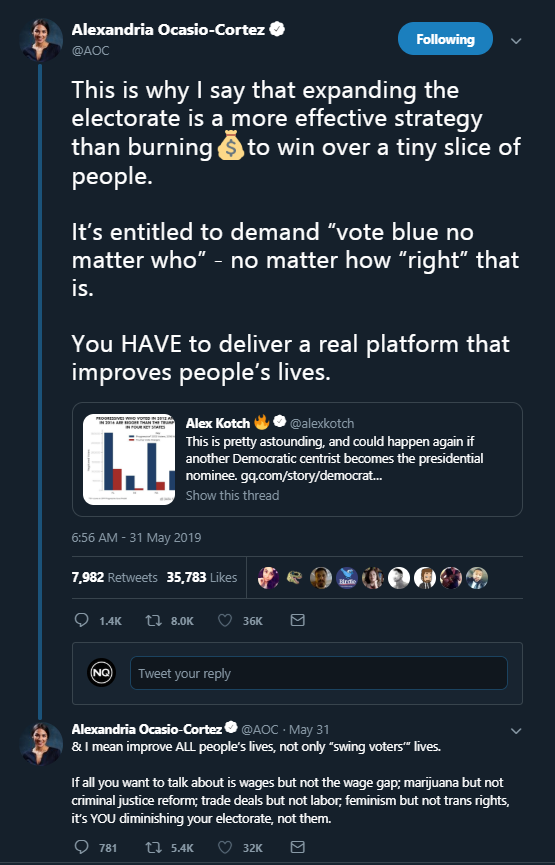By Kent R. Kroeger (Source: NuQum.com; June 10, 2019)
The hashtag #NoMiddleGround regularly trends on Twitter these days, as Democratic Party progressives continue to react to candidate Joe Biden’s unapologetic embrace of centrist policy ideas — when he’s not flip-flopping.
As one Bernie Sanders supporter put it: “The common threads between almost all #centrists are self righteousness and a complete lack of moral integrity.”
“They are the Democrats’ version of deplorables,” another added.
That is rather harsh. And, unfortunately, a dangerous misunderstanding of how electoral politics work in this country and is a large reason why the Democrats often find ways to lose elections they should otherwise win.
Centrists are not necessarily moderates
Some definitional clarity will help before we move forward. Centrists are not necessarily Moderates. The center is a relative concept. By definition, there is always a center point in a one- or multidimensional distribution. There may not be a lot of voters in the center, but there is still a center. On the other hand, being a ‘moderate’ is a self-description of where people put themselves on an ideological scale. In this essay, for the most part, I use the term ‘center’ or ‘centrist’ to indicate the relative positions of voters within an ideological distribution of all voters.
As an example, Hillary Clinton won among self-described moderates in 2016 — but she did not appeal to the nation’s center-of-gravity, which in that election was significantly to the right of where the country’s voters stand today.
With that distinction in mind, there are three rules that generally apply in presidential politics:
(1) You can’t win if you don’t excite the party’s ideological base.
(2) Centrist voters are important to winning most presidential elections.
(3) Ideological voters don’t necessarily prefer ideological candidates and centrist voters do not necessarily prefer centrist candidates.
That last rule is the tricky one. And therein lies the challenge facing presidential candidates, regardless of their placement on the ideological* spectrum. *(Ideology is not the same as partisanship)
Starting with Obama’s 2008 campaign, the Democratic Party’s research brain trust has mostly rejected the ‘centrist’ strategy in favor of a ‘turnout’ strategy that emphasizes “Get-Out-The-Vote” (GOTV) efforts focused on loyal and ideological Democrats (Rule #1). Still, to address Rule #2, they picked a centrist presidential candidate.
But they stumbled on Rule #3, as there is no certain way to approach it. Rule #3 is often why charisma is considered crucial to any presidential candidate. But what is that? For all the talk and effort trying to define charisma, it is not easily quantified or identifiable.
Rule #3 is the sticky wicket and why presidential campaigns tend to focus on the first two rules, often to their downfall.
Centrists are the new ‘deplorables’
It is a sentence that will follow Hillary Clinton to the grave: “You could put half of Trump’s supporters into what I call the ‘basket of deplorables.’”
With those words, former Secretary of State Hillary Clinton augured her own defeat in the 2016 presidential campaign.
Though more than a few pundits and social scientists pointed out she wasn’t entirely wrong, as a political strategy it was an arrogant failure.
She didn’t just write off over 20 percent of the electorate, she gave ‘undeplorable’ centrists and #NeverTrumpers the political cover to hold their noses and vote for Donald Trump. Clinton — known for her discipline — committed an unforced error from which there was no easy recovery.
Perhaps she was over-confident? Barack Obama said basically the same thing with his 2008 comment about conservatives clinging to ‘their guns and religion’ and he won twice. But Obama was a generationally transcendent candidate. He had some margin of error to work with in 2008 and 2012. Hillary did not.
Though their words on the campaign trail were ill-considered, Obama and Clinton were merely bringing relatable imagery to the Democrats’ dominate campaign strategy over the past twenty years: Win the turnout battle and Democrats win the election.
It is John B. Judis’ and Ruy Teixeira’s Emerging Democratic Majority thesis, which says Democrats have such a growing and increasingly dominate demographic advantage over the Republicans, all they need to do to win elections is to get their voters to the polls.
In practice, it becomes…Damn the deplorables and religious gun clingers! We don’t need them. And that is true. They don’t.
And yet they still lose. Why? The answer may lie in the bad rhetorical habits that develop when candidates (and political parties) assume a third of the voter population is irredeemable, coupled with selecting a centrist candidate that may work against the GOTV strategy.
The perfect candidate for the Democrats (and Republicans) is an ideologically-distinctive candidate that also appeals to the center. Easier said than done.
The ‘anti-deplorable’ strategy fostered during Clinton’s 2016 campaign went too far in its over-interpretation of Judis and Teixeira’s research and compromised the candidate’s appeal to the center.
Winning national elections requires broad appeal.
The Democrats have learned nothing from 2016
Clinton’s ‘anti-deplorable’ rally cry has morphed into an even worse ‘anti-centrist’ approach within the Democrats’ most progressive wing. New Yorkmagazine’s Eric Levitz wrote soon after the 2016 election that the Democrats don’t need to appeal to the center because “the center no longer exists.”
Oddly, Levitz supported his argument by presenting a Dr. Lee Drutman (YouGov.com) generated graph showing a significant and decisive percentage of the 2016 electorate holding centrist opinions on economics and social issues. The graph makes one clear point: If Clinton had won a majority of their affections, the cable news networks would probably be talking about impeaching President Clinton right now.
Instead, progressive Democrats are deciding if even centrists are acceptable. To the far-left, centrists are the neo-deplorables and spend even a little time on social media and you will see how corrosive this debate has become and how it is splitting the party.
“Centrists are actually SQWs: status quo warriors,” says progressive activist Sally Hunt (@sallybhunt). “Their energy, passion, and motivation always lies in trying to shut down and invalidate every single important discussion about oppression, abuse, injustice, power imbalances, and exploitation in society.”

In response, the centrist-aligned media implores Democrats to believe Trump’s base is not impregnable and that the ‘right candidate’ can win them over to the Democrats in 2020.
“The number one thing I would say is winning elections isn’t just about mobilization,” Yair Ghitza, chief scientist at Democratic voter-targeting firm Catalist, said in an interview with CNN. “I do think that’s something some people argue, and it’s gained a bit of traction. What I try to point out here is that mobilization is incredibly important. But the idea that there are literally no swing voters left, is, I think, a misreading of a lot of the data that’s out there.”
That fact that Ghitza needs to address whether there are any swing voters left tells us how disconnected from reality many in the Democratic Party have become over the past two years.
In this dispute, the Democratic Party establishment has only themselves to blame for the internecine warfare. By using the Russiagate investigation and other apocalyptic tropes to confront Trump, they have goaded the far-left elements in their party to accept nothing less than the removal of Trump from office — which isn’t going to happen until, at the earliest, Election Day. Until then, the establishment will be holding a pit viper by the back of the head and unable to let go.
Is mobilizing progressives enough?
A recent article by GQ’s Alex Kotch offers a nice counterpose to Ghitza’s research and the centrist strategy. Using YouGov.com survey data, Kotch argues the Democrats would have won in 2016 had they just convinced more of their progressive base to vote.
“When Democrats mobilize their base, they win,” writes Kotch. “Mobilizing the Democratic party base means standing up for progressive values, principles, and policies — and reaching out to the people it claims to represent. In the Data for Progress and YouGov Blue “What The Hell Happened” survey, we found overwhelming support among 2018 voters for policies like Medicare for All, the Green New Deal, and free college.”
To support his case, Kotch offered this chart (Figure 1) from the Data for Progress survey showing how, had progressive voters in 2012 not sat out in 2016, Hillary Clinton would have won in four battleground states. She would have won the election.
In Florida, slightly more than 300,000 progressive voters that voted in 2012 did not vote in 2016. Given the 100,000 vote gap between Trump and Clinton, that is compelling evidence to support the base mobilization strategy. These ‘defectors’ made up two percent of the all registered voters in Florida, and a similar percentage in Michigan, Pennsylvania, and Wisconsin. It is not a huge proportion of the population, but large enough to target cost-effectively with GOTV campaigns.
Figure 1: Progressive Turnout in 2016 from Four Key States

Attention to Kotch’s article blossomed after New York Representative Alexandria Ocasio-Cortez quickly tweeted back with this comment:

“This is why I say that expanding the electorate is a more effective strategy than burning (dollars) to win over a tiny slice of the people,” tweeted Ocasio-Cortez. ‘It’s entitled to demand ‘vote Blue not matter who’ — no matter how ‘right’ that is. You HAVE to deliver a real platform that improves people’s lives.”
Soon after her first tweet, Ocasio-Cortez tweeted again emphasizing her belief that focusing on swing voters is a mistake: “& I mean improve ALL people’s lives, not only “swing voters” lives.”
Kotch and Ocasio-Cortez have good reason to lament how Clinton failed to energize progressive voters. She did not mobilize her party’s base and she paid a price for it. But mobilizing the base is only part of the story (recall the Three Rules from above). The Democrats need a more holistic view of the electorate. And, yes, that means paying attention to centrists and the dreaded “swing voters.”
Using survey data from the 2016 American National Election Study (ANES), I categorized eligible voters along three factors: (1) Their self-described political ideology, (2) their 2012 presidential vote decision, and (3) their 2016 presidential vote decision.
[Note: Data for Progress constructed an index using policy-based survey items in order to identify ‘progressive’ voters. For the purposes of this essay, ANES’ self-described ideology survey item is sufficient to identify ‘progressive’ voters. For the ideological extremes, there is a strong correlation between constructed policy-based ideology indexes and self-reported survey items (e.g., ‘Progressives’ are far more likely to call themselves ‘very liberal’ or ‘liberal’ compared to other respondents — my own research documenting this can be found here).]
From the perspective of the Democratic Party, there are only three things an eligible voter can do: (1) Vote for the Democrat, (2) Vote for the Republican, or (3) Not vote (including voting for a third party candidate — which is equivalent to not voting from a major party perspective). Over two election cycles, that leaves nine possible categories (see Figure 2).
Klotch and Data for Progress focused on the ‘progressive’ defectors. In my analysis I identified an equivalent group — ‘liberal’ defectors — who accounted for two percent of all eligible voters in 2016, according to the ANES data. This proportion is consistent with the Data for Progress/Klotch numbers. As a comparison, the Republicans had their own defector group in 2016: Conservative Romney Republicans who voted for Clinton (or did not vote) in 2016. They were similar in size to the ‘liberal’ defectors.
Figure 2: Summary of ANES Respondents’ Presidential Vote Decisions in 2012 and 2016.

But there was another important group of eligible voters in 2016 that should not be ignored in 2020 by the Democrats: Centrist defectors to the GOP. These were ‘slightly liberal’ or ‘moderate’ voters that had voted for Obama in 2012 but did not support Clinton in 2016. This group made up five percent of eligible voters — at least twice the size of the ‘liberal’ defectors. Is that a group the Democrats think they can ignore in the next election because they voted for Trump and its a waste of money and energy to give them a reason to come back to the Democratic Party?
Ocasio-Cortez is correct about this: It is much more time consuming and expensive to canvass centrists and moderates than it is to target the party’s base in GOTV efforts. That is how a business thinks. That is how an economist thinks. But that is not how a presidential campaign should think.
The goal is to win an election, not have the biggest campaign bank account on election day. Does Democratic Party nominee want to say the day after the election, “We lost, but we did have the most cost-effective campaign in history!”?
Both presidential candidates and parties will have a campaign chest north of $2 billion in the general election. Without doubt, the Democrats can set aside significant money to communicate with working class centrists/moderates in Michigan, Wisconsin and Pennsylvania who defected to the Republicans in 2016. And if the Democrats don’t, the Republicans most certainly will.
If the Klotch/Ocasio-Cortez argument were merely an argument about emphasis and not a call to disregard working class Democrats that voted for Trump, I’d would not be alarmed. The Democrats cannot afford to have anyone in their progressive to stay home in 2020.
But they also cannot allow the Republicans to once again pick their pocket and walk away with five percent of eligible voters that should vote Democrat, all else equal. Ocasio-Cortez can call them a “tiny slice of the people,” but that tiny slice likely outnumbered progressive base defectors by 2-to-1.
Add to this equation the roughly six percent of eligible voters that defected to the Democrats in 2016 (conservative and centrist Republican voters in 2012). Even if they call themselves #NeverTrumpers, ignoring their interests and issue preferences does not feel like a sound strategy for the Democrats.
Centrists don’t necessarily prefer centrist candidates
Suggesting the Democrats are less likely to win in 2020 without support from centrist and moderate voters may sound like a sellout to the Democrats’ corporatist wing, but it is more like a bland truism.
The real dilemma facing the Democratic party (both parties, really) is picking a candidate that inspires the base and attracts moderates and centrists. That is not a contradiction. Quite the opposite, it is a template for victory repeated over and over in American presidential elections: Ronald Reagan, Bill Clinton, George W.Bush, and Barack Obama.
This electoral challenge has been known for years and was perfectly summarized recently by Salon.com’s Amanda Marcotte:
“…voters aren’t really inspired by playing it safe or moving to the center. Instead, candidates do better by convincing voters that this election is a historic moment and they don’t want to be left on the sidelines. There are a number of 2020 candidates who have that juice for different reasons: Bernie Sanders, Elizabeth Warren, Pete Buttigieg and Kamala Harris all seem to be generating excitement at their rallies. It could be catastrophic if Democratic voters, laboring under the panicky delusion that only a “centrist” can win, blow their chance to beat Trump by nominating exactly the wrong kind of candidate.”
While I disagree with some on her list of candidates with ‘juice,’ her point captures the disconnect that continues within the mainstream media when the topic becomes ‘Can Bernie or Biden unite the party’?
What Marcotte gets wrong — as do most political pundits — is that inspiring, historically relevant candidates don’t tend to be those that peddle empty platitudes. They must have a purpose for being a candidate. They must have some concrete reason for being president besides saying, ‘Trump is unfit to be president and I can beat him.’
Bernie Sanders leads on this front. I’ve interviewed hundreds of voters since 2016 and the issue that invariably gets mentioned as the most important is health care. Rich or poor, health care consumes their attention. And Sanders has a plan.
Tulsi Gabbard wants to end counterproductive regime change wars and is the least partisan-driven candidate I’ve ever met. Elizabeth Warren nails it on why the big social media companies need to be broken up and knows more about banking and finance than any other candidate since Bill Clinton. Jay Inslee has tangible ideas on addressing climate change. Andrew Yang wants universal basic income. As for the other candidates, their raison d’être is a mystery. Why are they running for president? They have answers to that question, but do you remember them?
Assuming a centrist candidate will broaden the party’s electoral coalition, or that a progressive candidate will shrink it, is not rooted in reality. Likewise, thinking a focus on turning out the progressive base will guarantee an electoral victory is not demonstrably better.
That is why attempts to tag ‘centrists’ as being unfit for the Democratic Party coalition serves no purpose. It demonstrates a fundamental misunderstanding of what motivates most voters. Centrist voters are Democratic voters in good Democratic years. So why would they be the enemy in any other year?
We saw firsthand in 2016 that labeling any voter a ‘deplorable’ serves no tangible strategic purpose except to allow undecided voters to sympathize with them and either vote for the opposing party candidate or not vote at all. Broadening that category to include ‘centrist’ voters is political suicide. It won’t work and, quite possibly, will splinter the Democratic Party.
Progressive Democrats don’t need to compromise on their policy ideas, but they do need to open their minds on who they think are open to their ideas.
- K.R.K.
